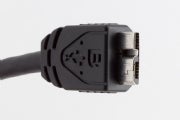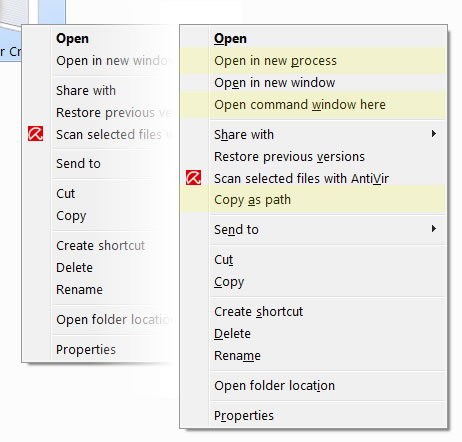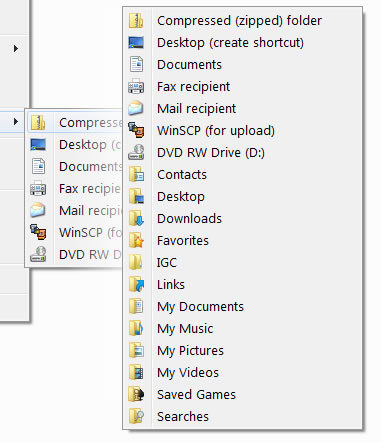
| Title | Date | Review / Report (PDF) |
Removal Test | October 2009 |
IT Information and News "Update"

| Title | Date | Review / Report (PDF) |
Removal Test | October 2009 |






 Those looking forward to the wide rollout of USB 3.0 are in for a major disappointment, if an unnamed industry source talking with EETimes is to be believed. Pointing out that the new interconnect "won't get real traction until it gets integrated in the chip sets," the source claims that Intel won't be offering motherboard integration before 2011, so vendors who want USB 3.0 will have to turn to costly third party controllers.
Those looking forward to the wide rollout of USB 3.0 are in for a major disappointment, if an unnamed industry source talking with EETimes is to be believed. Pointing out that the new interconnect "won't get real traction until it gets integrated in the chip sets," the source claims that Intel won't be offering motherboard integration before 2011, so vendors who want USB 3.0 will have to turn to costly third party controllers.
 Intel has quietly made a new addition to their "Bloomfield" series of processors, the Core i7 960. Coming in at the same 3.20GHz frequency as the original Core i7 965 Extreme Edition, which was replaced by the now flagship 975 Extreme Edition, the new chip will effectively take the 950’s position in the Core i7 lineup.
Intel has quietly made a new addition to their "Bloomfield" series of processors, the Core i7 960. Coming in at the same 3.20GHz frequency as the original Core i7 965 Extreme Edition, which was replaced by the now flagship 975 Extreme Edition, the new chip will effectively take the 950’s position in the Core i7 lineup. Most people sleep better at night knowing their PC is well equipped to thwart oncoming malware attacks. Out of paranoia some actually install multiple antivirus programs -- even though that's overly counterproductive.Indeed, with everything that you do on your computer and the information that resides on it, the safety of your sensitive data should be top priority. That said, with a little experience you can traverse the World Wide Web in peace with minimal security on active patrol.
Most people sleep better at night knowing their PC is well equipped to thwart oncoming malware attacks. Out of paranoia some actually install multiple antivirus programs -- even though that's overly counterproductive.Indeed, with everything that you do on your computer and the information that resides on it, the safety of your sensitive data should be top priority. That said, with a little experience you can traverse the World Wide Web in peace with minimal security on active patrol.
We've been playing with it ever since the beta became available, and can honestly say that much of the hype is justified. Although Windows 7 is still very much the same as Vista at its core, hundreds of small improvements make it work more smoothly, easier to navigate and overall better looking than before. With few exceptions, compatibility isn't expected to be a major issue either.
In preparation for the launch this week, we thought it would be a good idea to run through a few things worth keeping in mind before taking the plunge. If you are thinking about going Windows 7, read on.
There's been no shortage of coverage on Windows 7 -- here and elsewhere. But if you are still undecided on whether Microsoft's latest operating system is worth your hard earned cash, or are simply uninformed about what it has to offer, reading a few reviews online should help.
Engadget and WinSuperSite have long pieces sharing their hands-on experience with the final, RTM version of Windows 7. You can also have a look at our news archive and get the gist of what have been going on the past few months.
In contrast with Vista, Microsoft has cut down on the number of Windows 7 editions to just Home Premium, Professional and Ultimate. Although additional versions will be available for specific regions, the aforementioned three are what primarily will be available to the general public. A pretty straightforward chart comparing each of them on a feature-by-feature basis is available here.
You should know that retail versions of Windows 7 will include both 32-bit & 64-bit discs on the box so you can install either version. For a brief run down on the advantages and disadvantages each possess, check out our previous article on the subject.
Microsoft will be granting both Windows XP and Vista users the right to buy "Upgrade" versions of Windows 7, which run for considerably less money compared to a full license. However there are a few considerations one must take into account, such as the Windows edition you are upgrading from. In an attempt to smooth things out for our readers, we've created a condensed, easy-to-digest reference with all of the potential paths.
If you bought your computer in the last couple of years or are already running Windows Vista smoothly, then you are probably all set as far as hardware requirements are concerned.
If you need to be 100% sure you are covered, Microsoft provides a simple upgrade tester called the Windows Upgrade Advisor, which scans your hardware, devices, and installed programs for known compatibility issues, gives you guidance on how to resolve potential issues found, and recommends what to do before you upgrade.
If you haven't been running any of the test releases as your main installation, setting up Windows 7 on top of your existing copy of Windows may feel a bit premature. Thankfully, setting up a dual boot configuration is both easy and practical, so you can run both side by side until you are ready to make the switch. Whatever you decide, it's just as easy to go back to your previous configuration following our partition removal guide.
Microsoft is currently giving anyone with a valid .edu email address the chance to buy a Windows 7 Home Premium or Professional license for just $30. This offer is valid through January 3, 2010 which gets you a digital copy of the operating system in either its 32 or 64-bit version.
If you missed the initial pre-order discount, or don't qualify for the current student offer, going for an OEM copy of Windows 7 may be the next best thing in terms of savings. You'll get no phone support or fancy boxes, and will have no other choice than to perform a clean install (which we recommend anyway), but the up to 50% lower price tag is definitely worth it in our opinion.
Don't forget that for the first time Microsoft is offering the Windows 7 Family Pack. This includes three Home Premium upgrade licenses for $150, which equates to just $50 per user, or about the same price as the initial pre-order offer.
Windows Vista users may choose to perform an in-place upgrade, but we recommend a clean installation. Remember to back up your stuff and take a look at some useful applications to install on your fresh Windows 7 system.
AMD’s graphics division, the former ATI Technologies, loves a good surprise. The company has been a perennial also-ran in the graphics performance arena, but every now and then, it one-ups the competition in a big way. That happened back in 2002, with the launch of the original Radeon 9700, which stole the performance lead from archrival Nvidia. It happened again last year, with the Radeon HD 4800 series. The 4850, 4870, and 4890 weren’t always faster than the competition, but they were small, efficient chips that forced Nvidia into a price war that was good for users but bad for Nvidia’s bottom line.
Now AMD’s doing it again, putting some serious hurt on the competition with the first GPU to support Microsoft’s upcoming DirectX 11 API. AMD’s also been paying close attention to the emerging market for non-gaming apps accelerated by GPUs, such as video transcoding and digital photography, fully supporting DirectCompute 11 and OpenCL standards for general purpose computing on graphics cards.
This new chip is no shrinking violet in the numbers department. Every number associated with the new Radeon 5800 series is staggering: 2.15 billion transistors, 2.7 trillion floating-point operations a second, more than 20 gigapixels per second throughput, 1,600 shader units. Other numbers impress because of their smallness. One example: The idle power is a scant 27W— lower than many entry level GPUs.
Given the sheer scale and ambition of this GPU, does it deliver in the performance realm? And will it deliver at a price normal humans can afford? Let’s find out.
Two years ago, AMD’s ATI division decided to bow out of the game of building huge, hot chips that were expensive to make, ceding the high-end glory to Nvidia’s GT200 chip. That’s not to say AMD gave up on performance; it instead adopted the mantra of building the best performance GPU within a certain cost and power envelope. The Radeon HD 5800 series, originally code-named RV870, is the culmination of that approach. Taking advantage of Moore’s Law, ATI’s designers were able to build a GPU with few compromises using a 40nm manufacturing process.
| Radeon HD 4890 | Radeon HD 5870 | |
|---|---|---|
| Die Size | 263mm-squared | 334mm-squared |
| Transistor Count | 956 million | 2.15 billion |
| CPU Clock | 850MHz | 850MHz |
| Memory Clock | 975MHz | 1200MHz |
| Memory Quantity (GDDR5) | 1GB | 1GB |
| Manufacturing Process | 55nm | 40nm |
| Stream Processors | 800 | 1600 |
| Texture Units | 40 | 80 |
| ROPs | 16 | 32 |
| Maximum Board Power (TDP) | 160W | 188W |
| Idle Power | 90W | 27W |
The new GPU is just 334mm2—30 percent larger than the earlier 4870 GPU, but packing more than twice the number of transistors.
At 27W, the idle power is astonishingly low for such a large chip. The key factor was enabling lower memory clocks and voltages during idle, a feat made possible because of significant improvements in the 40nm manufacturing process. The net result is very low power when the board is just rendering your Windows desktop. At the same time, the VRM (voltage regulator module) interface has been improved, preventing overheating while allowing somewhat higher power consumption when performance is actually needed.
So the HD 5870 can draw less power while it’s doing nothing. But we also expect to see better performance, particularly given some of the other specs listed by ATI. The faster memory gives the 5870 overall memory bandwidth of 153GB/s. Feeding that huge pipe is a GPU with twice as much hardware where it matters—stream processors, ROPs, and texture units.
The graphics engine itself sports some new features—particularly the hardware tessellation engine. While past ATI products have offered hardware tessellation, the new engine fully supports Microsoft’s DirectX 11 tessellation API. ATI is fond of pointing out that this is actually its sixth generation tessellation hardware.

Intel is preparing for launch of the 32nm six-core processor codenamed Gulftown in 1H 2010 according to Fudzilla, and the enthusiast JC has managed to grab the sample of Core i9 Gulftown.
With support for Socket LGA1366, Gulftown is based on 32nm technology, operating at 2.4GHz (18*133MHz), with 12MB of L3 cache.

Compatible with the X58 chipset, Gulftown is really something to look forward to.